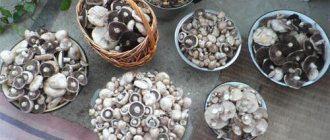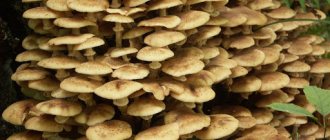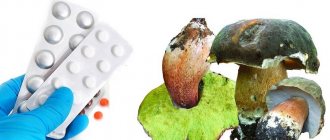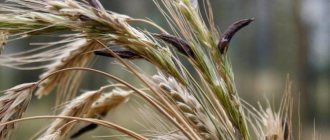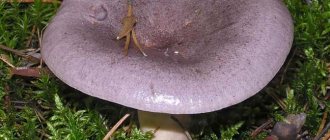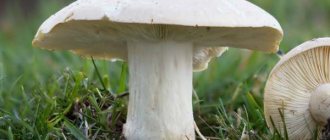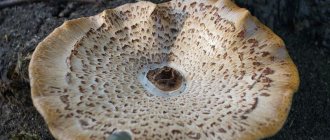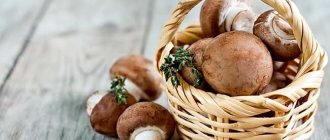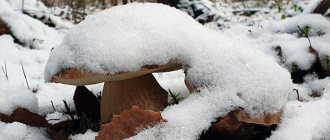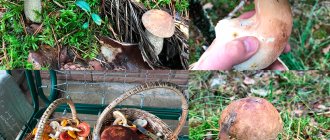| ✈✈✈ List of open countries during coronavirus. ✈✈✈ Where to go on vacation abroad ✈✈✈ |
8 267
In this post:
- Where and when to pick mushrooms.
- Edible species.
- Poisonous, non-edible mushrooms of Crimea.
Crimean flora and fauna are diverse and unique due to climatic conditions. Particular attention should be paid to the huge number of types of mushrooms. In total, there are more than 100 species on the peninsula. But before you go on a “silent hunt”, it’s worth figuring out where and what kind of mushrooms grow.
What time are mushrooms picked in Crimea?
The following areas are considered the most famous mushroom places in Crimea:
- Kolchugino;
- Stroganovka;
- Zelenogorskoe;
- Marble;
- Demerdzhi district;
- forest areas of Radiant;
- District Astrophysical Observatory;
- estuaries Donuzlav and Sasyk;
- forests of Simferopol, Bakhchisarai, Belogorsk, Kirov regions.
Crimean mushrooms begin to be collected in early spring. And the last fruits can be found 2 weeks before the New Year holiday. Each mushroom species has its own individual fruiting dates and preferences for places of growth:
| Species name | Fruiting period | Gathering places | Mycorrhiza formation |
| Chanterelles | the beginning of June; August-November | forests of any type, most often coniferous and mixed forests | spruce, pine, oak, beech |
| Saffron milk caps | July-October | pine, spruce forests | – |
| Champignon | July-October | forests of various types, plantings, parks, steppes and even garbage heaps | – |
| Mountain white mushroom | mid-spring – early autumn | mountain forests, steppes, deciduous forests | – |
| Caesar's mushroom | June-October | sparse forests, under chestnuts and oaks, as well as near hazel, birch, and beech trees | – |
| Little mice (gray rows) | early – mid-autumn | coniferous and mixed forests | pine |
| Rogatiki | June-September | deciduous forests | – |
| Dung beetles | May – autumn | manure heaps, vegetable gardens, orchards, fields, lawns | – |
| Butter | June – October | predominantly coniferous forests | conifers |
| Milk mushrooms | all summer | forests of any type | depends on the variety |
| Raincoats | June-November | coniferous and deciduous forests | – |
| Oyster mushrooms | massively – September-October | deciduous foothill forest areas | – |
The data presented in the table are conditional, statistical averages. The climatic conditions of Crimea are sometimes unpredictable. Often in one part of the peninsula there is still snow, while in another the mushroom season is already underway.
Recipe for quick-cooking salted saffron milk caps
You can eat saffron milk caps raw, just sprinkle them with a little salt. But it's better not to take risks. And if you really want to quickly enjoy the taste of the delicacy, try pickling them according to a quick recipe. The mushrooms will be ready in 2 hours and can be safely eaten.
In this way, it is best to salt a small amount of saffron milk caps, otherwise they will become over-salted and will simply be impossible to eat.
Quantity of ingredients
- Ryzhikov - take about 500 g
- We use more salt than with regular salting. If for regular salting you take 2 tbsp per 1 kg of forest products. l. salt with a large heap, then for quick salting it is taken 5 times more. By simple calculation it turns out that for every 100 g of saffron milk caps you need to take 1 tbsp. l. salt.
How to salt
Step 1. Wash the mushrooms and cut off their stems, since the stems take much longer to salt than the caps.
Step 2. Pour a little salt into the bottom of a small bowl, place the caps on top, and sprinkle each layer with salt.
Then cover the bowl with a plate, put a little pressure on it and put it in the refrigerator for exactly 2 hours. If you overdo it even a little, the mushrooms will turn out too salty. And that’s why it’s better not to add salt to them than to over-salt them.
Step 3. After 2 hours, we take the saffron milk caps out of the refrigerator, they have already given juice. Place them in a colander and rinse them under running water to remove excess salt.
Once washed, transfer them to a clean plate. This delicacy should be eaten as soon as possible, preferably within 24 hours.
When serving, add onion, cut into thin rings or half rings, to the plate with mushrooms. If desired, you can season with a little chopped garlic. Season with sour cream or vegetable oil and serve.
Description of edible Crimean mushrooms with names
There are many edible species found on the rich Crimean lands. Among them there are also very rare mushrooms.
Chanterelles
Bright and very beautiful mushrooms. The cap and stem form a continuous fruiting body without visible transitions or boundaries. The caps are funnel-shaped, with wavy and turned-down edges. They are slightly flattened on top. A series of ribbed plates extends down from the cap.
The leg tapers at the base. The body of the fruit is colored in light shades of orange - red, pale orange, yellow-orange, whitish-orange. When pressing on the leg, the damaged area turns red.
Saffron milk caps
Quite large mushrooms. The diameter of the cap of the saffron milk cap can reach 14 cm. The cap itself has a convex shape with rolled edges. As it ages, it straightens out, taking on a funnel-shaped shape. The hats are mounted on smooth, slightly narrowed legs at the bottom. Their surface is dotted with small depressions.
The fruiting bodies of saffron milk caps are orange. The hats may be a little brighter than the legs. There are dark concentric circles and spots on their surface. The flesh of these mushrooms is also red.
At the break it turns green, and a large amount of orange milky juice flows out of the damaged area. When exposed to oxygen, the milk also turns green. The pulp of saffron milk caps has a pleasant fruity aroma.
Champignon
Forest champignons are large-sized mushrooms with massive caps on thick cylindrical legs. The shape of the cap changes depending on the age of the fetus. In young champignons it is round, in adults it is noticeably flattened.
There are always one or two mushroom rings on the stem. Depending on the species, the fruits can be colored in shades of white, brown and brown. In some varieties, the surface is covered with scales.
Champignons have a lot of doubles. The main distinguishing feature of edible mushrooms is the color of their lamellar layer. As the fruit ages, it changes from pinkish to almost black. False champignons have white plates, as a rule.
Mountain white mushroom
This species has no relation to the noble porcini mushroom from the genus Boletaceae of the Boletaceae family. The mountain porcini mushroom is called the Crimean giant talker (Ryadovaceae family).
The fruits reach quite large sizes. The diameter of the talker's cap varies from 8 to 30 cm. In young mushrooms, the caps are slightly depressed, smooth, but in old ones they become deeply funnel-shaped and covered with age-related cracks.
The legs of giant talkers are short and thick. Their surface is smooth, without signs of remains of the blanket and mushroom rings. The fruiting bodies are creamy white. The indentation area on the cap is always darker.
In addition to being edible, this species also has valuable medicinal properties. The fruits of the giant talker contain a natural antibiotic, which traditional medicine uses in the fight against tubercle bacillus.
Caesar's mushroom
Other names: Caesar's mushroom, Caesar's fly agaric. The initially ovoid-hemispherical cap transforms with age into a convex-prostrate one. As the mushroom matures, the color of its cap also changes. At first it is represented by bright shades of orange, and then it turns yellow.
The leg is strong, club-shaped, with a light yellow or golden surface. It has a distinct yellow ring on it. It is this that is considered the defining feature when compared with the red fly agaric, which has a white ring.
Interesting! Caesar's mushroom has been highly valued since antiquity. It belongs to the edible mushrooms of the first category.
Little mice or rows of gray
The wide bell-shaped caps of young rows transform into prostrate ones over time. Old mushrooms have cracked edges. There is a characteristic tubercle in the center of the cap. The leg is high and thin. It is often curved. The legs of rows tend to bury themselves in the soil.
The cap is painted light gray, the leg is always a little lighter. Often its color has a yellowish tint. The pulp has a sweetish taste and floury aroma, characteristic of most edible rows. Rows are used to prepare a variety of dishes, but only subject to mandatory heat treatment.
Rogatiki
Externally, mushrooms resemble corals. There are two types of stags common in the Crimean lands:
- Yellow - large fruits of cream or lemon color, acquiring an ocher or orange hue with age.
- Bunch - small branched tufts of brownish-cream color with pink or brick-brown tips.
Despite their unusual appearance, horned mushrooms are not only edible, but also very tasty mushrooms. Therefore, it’s definitely not worth passing by the “coral thickets”.
Dung beetles
Young mushrooms have a shaggy and spindle-shaped cap. As it matures, it takes on a bell-shaped shape. The surface is white, but in the center there is always an almost black tubercle, from which the “blackening” begins. The leg is long, thin, painted white. It has a movable ring.
Only young dung beetles are eaten. The age of the fetus can be judged by the color of its plates - they should be white. Black plates indicate that the dung beetle has already entered the ink stage.
Butter
The cap and stem of the oiler are slippery to the touch, and in wet weather they also become sticky. Young mushrooms have convex caps. With age they flatten out a little. The color of the cap depends on the type of oiler. It can be made in yellow, orange, brown tones.
The color of the leg matches the color of the cap. The leg itself is club-shaped, decorated with a dark mushroom ring. The flesh of the oiler is light, but when it comes into contact with air it turns red or blue.
Milk mushrooms
The vast majority of species have flattened caps, with a characteristic depression in the central zone. Milk mushrooms with funnel-shaped caps are less common. The edges of the cap can be either smooth or wavy. The color is varied and can be the following colors:
- white;
- yellow;
- brown;
- brown;
- grey;
- beige;
- pink;
- lilac;
- blue;
- olive black.
The legs are cylindrical, usually central. The color always matches the cap. The pulp of edible milk mushrooms is highly valued. It has a spicy peppery taste and fruity aroma.
Raincoats
The Raincoat genus has only 5 varieties. And they all belong to the edible category. The main thing is not to confuse the raincoat with its inedible counterparts.
In Crimea you can find only 2 species:
- Giant - round fruits with a diameter of up to 34 cm.
- Pear-shaped - mushrooms whose shape resembles a pear.
The fruits of puffballs are white. They don't have legs. The lower part of the body, which inexperienced mushroom pickers mistake for a leg, is actually a continuation of the cap. The surface of the raincoats is covered with spike-like growths, which easily fall off with gentle pressure.
Oyster mushrooms
In Crimea, the oyster or common variety of oyster mushroom is common. People call it glyva.
The caps are funnel-shaped or ear-shaped. One edge of the cap is often turned up. The surface is matte, smooth. It can have any shade of gray - from light ash to dark gray. The legs are short, always lateral and curved.
Oyster mushrooms grow in large bunches. One bunch often contains more than a dozen fruits.
Recipes for making saffron milk caps - how to cook them
Having collected a rich harvest of saffron milk caps, you can not only fry them, for example, with butter and sour cream, or cook soup with them, but you can also prepare them for future use for the winter. When preparing for the winter, mushrooms are often salted or pickled.
You can pickle cold or hot. If you choose the cold method, be prepared for the color of the finished delicacy to become dark. Hot salting is good because their color does not change and remains the same.
What poisonous mushrooms in Crimea are most often confused with edible ones?
Among the poisonous Crimean mushrooms, the most dangerous are fly agarics, false honey mushrooms and toadstool.
Fly agarics
A poisonous mushroom can be identified by the following signs:
- bright orange-red or red cap with numerous white warts;
- there is a white or whitish-yellow ring on the stem;
- the base of the stalk is fused with a sac-like vagina and is also covered with warts.
This species of fly agaric does not smell of anything. Warts can be washed away by rain, which can cause the surface of the cap to become smooth.
False honey mushrooms
Sulfur-yellow honey mushrooms are characterized by the following features:
- a bell-shaped or outstretched cap of a sulfur-yellow hue with a darkening center and lighter edges;
- sulfur-yellow plates in young fruits;
- bitter pulp with an unpleasant odor.
Poisonous honey fungus is often mistaken for an edible species.
Death cap
The mushroom has the following features:
- presence of a ring;
- bag-like white volva around the base of the stalk;
- smooth surface of the cap and white plates that do not change color over time.
Pale toadstool is often confused with edible floaters, some russulas and mushrooms.
Hot salting of saffron milk caps in jars – method No. 2
When salted in this hot way, the mushrooms remain natural in color. They turn out quite strong, crispy and, of course, tasty. And they are perfectly stored until the next season.
How to cook
Step 1. The saffron milk caps are sorted and washed with water.
Step 2. Pour water into the pan and add salt at the rate of 50 g of salt (2 tbsp) per 1 liter. Place the mushrooms in the brine and let them simmer for 10 minutes.
Step 3. While the saffron milk caps are boiling, prepare the marinade. For 1 liter of water take:
- 2 tbsp. l. Sahara
- 4 tsp. salt
- 4 bay leaves
- 6 allspice peas
- 3 cloves.
- 3 pieces of cinnamon (or 0.5 tsp ground)
Step 4. Place the boiled mushrooms in a colander and immediately place them in pre-sterilized jars.
Step 5. Fill with hot brine and immediately roll up the jars with lids.
From 1 kg of boiled saffron milk caps, one liter jar of the preparation is obtained.
Advice from experienced mushroom pickers on collecting edible fruits
You may be interested in: How do edible talkers differ from false mushrooms? How many days after rain do mushrooms grow? Bitter mushroom: photo and detailed description
Avid mushroom pickers willingly share their experience of mushroom picking, giving less knowledgeable fans the following recommendations:
- if there is any doubt about the edibility of a mushroom, it is better to leave such a fruit in the forest;
- You should go looking for mushrooms in well-known mushroom places so as not to return with an empty basket;
- even noble mushrooms can be poisonous if they grow near busy highways and industrial sites;
- breaking out and twisting the fruits can cause damage to the mycelium, and it will stop bearing fruit - it is better to use a knife;
- they go shopping for mushrooms with baskets, because in plastic bags the fruits wrinkle and lose their attractiveness;
- some species (for example, caesarean mushroom) are listed in the Red Book of Crimea - they cannot be touched.
Mushrooms are no joke! To avoid troubles, it is better to carry out your first trips with experienced mushroom pickers.
A simple recipe for cold pickling of saffron milk caps
Ryzhiki are one of those mushrooms that, when pickled, do not require the addition of pepper, garlic or other spices. They are delicious on their own. And raw foodists even eat them, simply dipping a piece into a salt shaker. However, most of us prefer to eat them salted.
The cold salting method is the simplest; the main thing here is not to overdo it with salt. Salt is taken here based on 1 kg of mushrooms: 40 g of salt - 1 tbsp. l. salt with a large slide.
How to cook
Step 1. The saffron milk caps need to be washed or even soaked for half an hour in cold water. However, if you plan to cover them later, for safety reasons and to prevent botulism, it is still better to rinse them thoroughly.
Step 2. Place the mushrooms in layers with salt into a wooden or enamel container. It is better not to use aluminum cookware, since oxidation is likely to occur and this is also not very good for health.
So we lay them all out, sprinkling each layer with salt.
By the way, mushrooms contain the antibiotic lactrioviolin, which is good for treating tuberculosis and other lung diseases. And if you accidentally get injured in the forest, apply a piece of camelina to the wound, this will speed up its healing. This healing patch will also help with insect bites.
Step 3. Place a plate on top and put pressure on it.
Leave the container in a cool place to pickle the mushrooms. And after 3-4 days they are ready to eat.
How to pickle saffron milk caps for the winter with vinegar - a simple recipe
Open a jar of pickled saffron milk caps, boil some potatoes and invite your loved ones to the table. You will arrange a wonderful and satisfying budget dinner for your family. And how good they are marinated for the holiday table! Try to cook them according to this recipe, you will definitely like them!
Ingredients
- Ryzhiki – 500 -600 g
- Bay leaf – 2 pcs.
- Allspice peas – 5 pcs.
- Cloves – 3 pcs.
- Acetic acid 70% - 0.5 tsp.
- Water – 100 ml
- Salt – 1 tbsp. l.
How to marinate
Step 1. Mushrooms are sorted out from debris and washed.
Step 2. Pour some water into the pan and transfer the prepared saffron milk caps there. Don't worry that there is not enough water. During the cooking process, they will release juice, it will be quite enough, and they will cook on it.
Step 3. Throw bay leaf, peppercorns and cloves into the pan. Since there are only a few saffron milk caps, 1 tbsp is enough for this amount. l. salt. If you need to marinate more mushrooms, increase the amount of spices and salt proportionally.
The brine should be slightly salted. When the mushrooms are in the jars, they will absorb excess salt and they will become very tasty.
Step 4. Close the pan with a lid and cook for about 7-10 minutes from the moment it boils. While cooking, taste the broth; it should be a little salty.
Step 5. Turn off the stove, and when the contents of the pan stop bubbling, add 0.5-1 tsp of saffron milk caps (about 0.5 liters) to this amount. acetic acid.
And while the mushrooms are hot, transfer them immediately into pre-sterilized jars. Lightly compact with a spoon, add a little marinade and close tightly with a plastic lid.
When the jars have cooled, put them away for storage in a cool place - in the refrigerator or underground.
Milk mushrooms
Mushroom pickers come across mushroom pickers in mixed forests in the summer. Rarely found in the foothills and mountainous regions of Crimea. The main harvest season is July and September. Active growth begins after heavy rains.
There are no real milk mushrooms in Crimea, but oak, pepper and dry milk mushrooms grow. Pepper milkweed can be distinguished by its funnel-shaped white cap with grayish spots. On its narrow plates drops of milky juice are noticeable, which tastes very bitter. The leg is short, narrowed below. You can eat the mushroom after repeated soaking.
The dry milk mushroom also has a white cap, but with brown spots. The plates have a bluish color. The bitter juice does not appear after breaking. The mushroom is ideal for pickling and pickling (after pre-soaking).
In the mountainous part of Crimea you can find oak milk mushrooms. These reddish lamellar mushrooms grow in deciduous forests. Brown stripes are easily visible on their caps. Legs with yellow pits lose their density as they grow. Suitable for marinating, frying, boiling.
